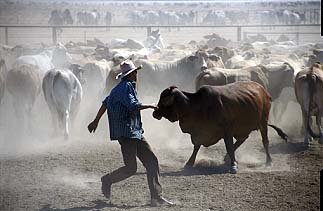Drought conditions continue to extend across eastern Australia. Unlike many other events, droughts are progressive.Not all properties enter drought in the same way or at the same time. At the same time, recovery from drought is often variable, depending on the strategies and the management of individuals throughout the drought.
Drought plans need to be responsive and change to adapt to the conditions. There are some important things in a drought plan. These are the critical dates of events – be it calving or lambing; shearing and joining for next year. There are also some critical trigger points. These can be the amount of water available; feed reserves; and importantly the enterprise budget. How much money should you use to feed vs. a decision to sell and buy back in later on?
Right now, many herds have commenced calving. This is a critical time in the annual calendar of any herd. In drought conditions, it is one of the most critical events.
When cows calve, their energy requirements double. This energy is needed to produce sufficient milk to support their calf. However in many instances, cows cannot eat enough energy to meet those needs. So cows will often lose weight in early lactation.
The flow on effect of weight loss is a delay in the return to oestrus. Cows in an average fat score (Fat Score 3) take on average 50 days to return to oestrus.In an ideal world this allows the cow to heat cycles to rejoin and so meet a production target of a calf produced every 12 months.
However if fat scores are lower than average (Fat Score 2) and below, the length of time to return to oestrus extends.T his sees calving spread out beyond 12 months.
In drought, most cows are already in low condition scores. The on going risk is these cows will struggle to join successfully in spring, without the added pressure of high-energy demands from raising a calf.
Over the long term recovery from drought is dependent on cash flow and resuming normal operations as soon as possible.For many beef producers lower fertility levels that are a direct result of cow condition during the drought period often compromise this recovery.
So what are the practical things producers can do? Here are a few strategies that could be considered in most drought plans.
Ensure your feeding program matches your cows needs and paddock conditions: Almost all feeding programs are now taking place where paddock feed is less than 1000kg DM/Ha. In these situations, protein supplements like roller drums are not only ineffective but a waste of money and time for you. More significantly these supplements do not address the limiting requirement of energy!
Draft cows into similar groups based on Fat Score; Weight and Production Status: Cow intake is driven by their liveweight and production status. So drafting cattle into mobs based on these factors will allow you to feed them more appropriate levels of an energy based supplement.
Dry cows will eat less than lactating cows, so it’s worth considering drafting lactating cows into their own groups so they can achieve the nutritional levels they require.
Plan ahead to early wean: For many people talking about weaning even before calving has ended might be a crazy suggestion! However if the season doesn’t improve, early weaning could be a very good strategy to reduce feeding levels of the cow herd. In other words dry cows need less feed, and you could feed them at a lower level. At the same time early weaning would allow you to manage your calf growth and keep them on track for market targets rather than suffering low growth from low levels of milk production. Successful early weaning needs to be planned, as you need to consider rations, space in yards and on going health programs.
Ultimately now is a critical time that needs you to refocus your efforts and make sure you are getting the most effective use from your available resources.If you are not sure or want a hand, you can always ask me to come out and help you draw up a new focus to your program.


































![Lot 7[1].jpg](https://images.squarespace-cdn.com/content/v1/5da3f3cd64169331e9219d64/1573094582042-DWJ37SGR39YOF5OH2NIX/Lot+7%5B1%5D.jpg)



















